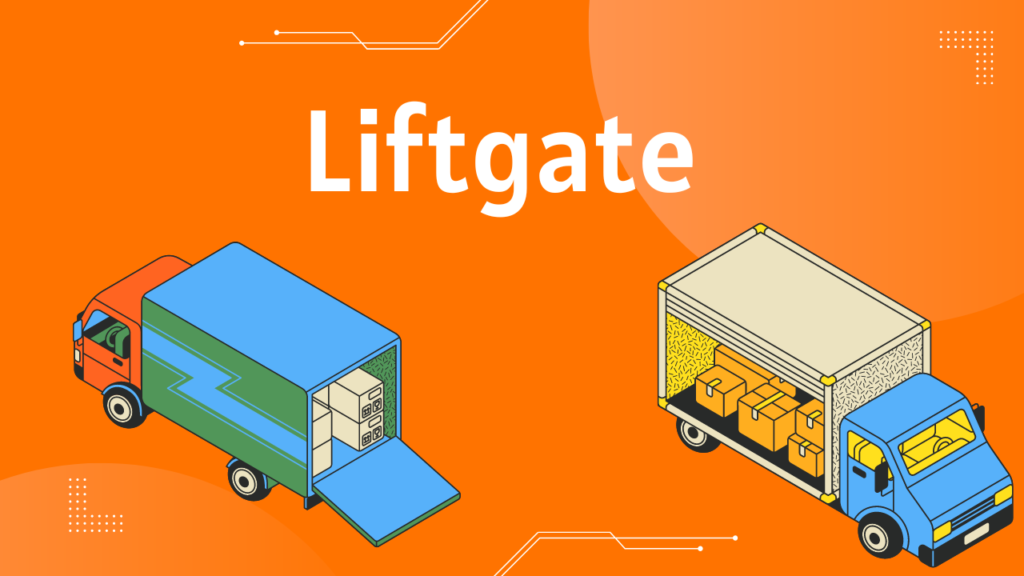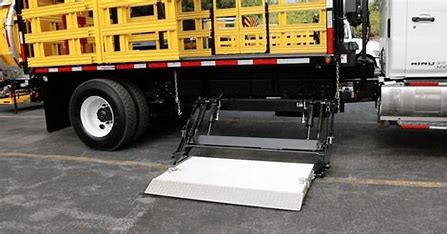
If you’ve ever ordered or shipped something that’s too heavy or too large to move by hand, you might have encountered the term liftgate. A liftgate is a piece of equipment attached to a truck or trailer that uses hydraulics to lift and lower shipments onto or off of the vehicle. In this article, we’ll explore the basics of liftgates, their benefits, types, features, costs, maintenance, and safety.
There are several types of liftgates that are commonly used in the transportation industry. The first type is the tuckaway liftgate, which is typically used on smaller trucks and vans. This type of liftgate is mounted underneath the rear of the vehicle and can be easily tucked away when not in use. The tuckaway liftgate is ideal for making deliveries in residential areas where space is limited.
The second type of liftgate is the rail liftgate, which is commonly used on box trucks and straight trucks. This type of liftgate is mounted on the rear frame of the vehicle and can slide along a rail system to accommodate different cargo lengths. The rail liftgate is ideal for transporting large and heavy items such as appliances, furniture, and machinery.
The third type of liftgate is the cantilever liftgate, which is commonly used on flatbed trucks and trailers. This type of liftgate is mounted on the rear of the vehicle and extends out horizontally to provide a large loading area. The cantilever liftgate is ideal for transporting oversized items such as construction equipment, vehicles, and boats.
When it comes to using a liftgate, there are a few important things to keep in mind. First, it’s important to make sure that the liftgate is rated for the weight of the shipment being transported. Overloading a liftgate can cause it to fail, which can be dangerous and costly. Second, it’s important to make sure that the shipment is properly secured to the liftgate to prevent it from shifting or falling during transport. Finally, it’s important to follow all safety guidelines and procedures when operating a liftgate, including wearing appropriate personal protective equipment and using caution when loading and unloading the shipment.
In conclusion, liftgates are an essential tool for transporting goods and materials safely and efficiently. Whether you’re making deliveries in a residential area or transporting oversized items on a flatbed trailer, there’s a liftgate that’s right for your needs. By understanding the different types of liftgates available and following proper safety procedures, you can ensure that your shipments arrive at their destination on time and in good condition.
The Types of Liftgates

When it comes to transporting goods, liftgates are an essential component of any delivery truck or trailer. These mechanical devices are designed to lift and lower heavy loads safely and efficiently, making the unloading process much easier and faster. There are several types of liftgates, each designed for a specific purpose and application:
- Tuck-under liftgates: These liftgates are attached to the underside of the truck or trailer, behind the rear axle. They are known for their compact design and are ideal for medium-duty delivery trucks. Tuck-under liftgates can support loads up to 3000 pounds, making them perfect for smaller shipments.
- Slider liftgates: These liftgates are attached to the rear frame of the truck or trailer, and slide in and out like a drawer. Slider liftgates are easy to operate and can support loads up to 5000 pounds, making them suitable for heavy-duty delivery trucks. They are also great for frequent deliveries, as they can be used multiple times throughout the day.
- Cantilever liftgates: These liftgates are similar to slider liftgates, but they extend out from the side of the vehicle. They are perfect for narrow alleys or driveways where space is limited. Cantilever liftgates can support loads up to 5000 pounds, making them suitable for medium to heavy shipments.
- Fold-out liftgates: These liftgates fold out horizontally from the rear of the truck or trailer. They are perfect for forklift loading, as they can support loads up to 6600 pounds. Fold-out liftgates are also great for larger shipments, as they provide a wide platform for loading and unloading.
- Vertical liftgates: These liftgates flip up vertically from the rear of the truck or trailer. They are ideal for high-volume shipping containers or warehouses, where space is limited. Vertical liftgates can support loads up to 6600 pounds, making them suitable for heavy shipments.
When choosing a liftgate, it’s important to consider the size and weight of the shipment, the delivery location, and the delivery frequency. Some carriers offer different types of liftgates, while others specialize in one or two types. It’s also important to choose a liftgate that is compatible with your truck or trailer, and that meets all safety standards and regulations.
Overall, liftgates are an essential component of any delivery operation, and choosing the right type of liftgate can make a big difference in terms of efficiency, safety, and customer satisfaction.
The Different Features of Liftgates
Liftgates also have different features that enhance their functionality and safety:
- Remote control: Some liftgates can be operated with a remote control, which allows the driver to stand clear of the platform and the shipment.
- Safety barrier: Some liftgates have a safety barrier that extends around the platform, preventing the shipment from falling off or sliding down.
- Non-slip surface: Some liftgates have a non-slip surface, which reduces the risk of accidents during wet or icy conditions.
- Adjustable height: Some liftgates have adjustable height settings, which allows the driver to match the height of the shipment with the loading dock or the container.
- Automatic folding: Some liftgates can fold automatically after use, reducing the risk of damage or theft.
The choice of features depends on the specific needs and preferences of the carrier, the driver, and the consignee.
Also checkout the importances of differences between 3PL Vs. 4PL Guide
Benefits of Using a Lift Gate

The benefits of using a liftgate for delivery and shipping are numerous:
- Easy loading and unloading: Liftgates remove the need for manual lifting or rolling, reducing the risk of injury and the time required for loading and unloading.
- Accessibility: Liftgates make it possible to deliver to locations without a loading dock or a ramp, such as homes, apartments, or construction sites.
- Flexibility: Liftgates allow carriers to handle a wider range of shipments, from heavy equipment to fragile items, with the same truck or trailer.
- Efficiency: Liftgates reduce the turnaround time and the fuel consumption required for loading and unloading, leading to lower operational costs and higher customer satisfaction.
The use of liftgates is particularly relevant for e-commerce, food and beverage, furniture and appliance, and construction industries, where home delivery and installation are becoming more common.
Are There Alternatives to Liftgate Delivery Services?
While liftgate delivery services are convenient and versatile, they may not be suitable for every shipment or every budget. Some alternatives to liftgate delivery services include:
- Manual lifting: This involves using human labor or mechanical equipment to lift the shipment onto or off of the truck or trailer. This can be a cost-effective option for small, light, or infrequent shipments, but it poses a higher risk of injury and delay.
- Pallet jack or forklift: This involves using a pallet jack or a forklift to move the shipment onto or off of the truck or trailer. This can be a faster and safer option for heavy or bulky shipments, but it requires a loading dock or a flat surface.
- Tailgate delivery: This involves using the vehicle’s tailgate as a makeshift liftgate. This can be a quick and dirty option for small or light shipments, but it poses a higher risk of damage or injury.
The choice of delivery method depends on the nature, volume, and destination of the shipment, as well as the carrier’s equipment and expertise.
The Cost of a Liftgate
The cost of using a liftgate varies depending on the carrier, the type of liftgate, the weight and volume of the shipment, and the distance and time required for delivery. Some carriers include liftgate fees as part of their standard pricing, while others charge a separate fee per use or per shipment. On average, liftgate fees range from $50 to $150 per shipment, but they can go as high as $500 for specialized or expedited services.
The cost of using a liftgate should be compared to the cost of using alternative delivery methods, as well as the cost of damage or delay caused by improper handling or lifting.
How to Maintain a Liftgate

Like any mechanical equipment, liftgates require regular maintenance to ensure their safety and reliability. Some tips for maintaining a liftgate include:
- Cleaning: Keep the liftgate and the surrounding area clean and free from debris, dirt, and rust.
- Greasing: Apply lubricant to the hinges, rollers, and pins of the liftgate to prevent friction and corrosion.
- Inspecting: Check the liftgate for any signs of wear, tear, or damage, such as cracks, leaks, or bent parts. Replace or repair any damaged parts immediately.
- Training: Train the drivers and the operators on the proper use and handling of the liftgate, including the weight limit, the safety features, and the emergency procedures.
- Testing: Test the liftgate periodically, including the hydraulics, the controls, and the safety features. Document the tests and the results.
The maintenance of a liftgate should be included in the carrier’s safety and compliance program.
The Safety Features of a Liftgate
Liftgates are designed to be safe and reliable, but accidents can occur if the liftgate is misused or malfunctioned. Some safety features of a liftgate include:
- Weight limit: Liftgates have a weight limit that must not be exceeded. Exceeding the weight limit can cause the liftgate to tip over or fail, leading to injury, damage, or loss.
- Safety barrier: Liftgates have a safety barrier that extends around the platform to prevent the shipment from falling off or sliding down.
- Controls: Liftgates have a set of controls that the driver or the operator must use to operate the liftgate. The controls should be located within the driver’s reach and sight, and clearly labeled. The controls should be maintained and tested regularly.
- Emergency stop: Liftgates have an emergency stop button or lever that the driver or the operator can use to stop the liftgate instantly in case of an emergency or a malfunction.
- Training: Liftgates require proper training and certification before use. The drivers and the operators should be familiar with the liftgate’s features, controls, and safety procedures.
The safety of a liftgate should be a top priority for the carrier, the driver, and the consignee. Any safety or compliance issues should be reported and resolved immediately.
Conclusion
Liftgates are a crucial component of modern shipping and delivery services. They provide a safe, efficient, and versatile way to move heavy or bulky shipments onto or off of trucks or trailers, and make it possible to deliver to locations without loading docks or ramps. The choice of liftgate depends on the type, weight, and volume of the shipment, the delivery location, and the delivery frequency. Liftgates come with different features, such as remote control, safety barrier, or non-slip surface, that enhance their functionality and safety. The cost of using a liftgate should be compared to the cost of using alternative delivery methods, as well as the cost of damage and delay. Liftgates require regular maintenance and testing to ensure their safety and reliability, and should be included in the carrier’s safety and compliance program. The safety features of a liftgate, such as weight limit, safety barrier, controls, emergency stop, and training, should be followed rigorously to prevent accidents and injuries.
